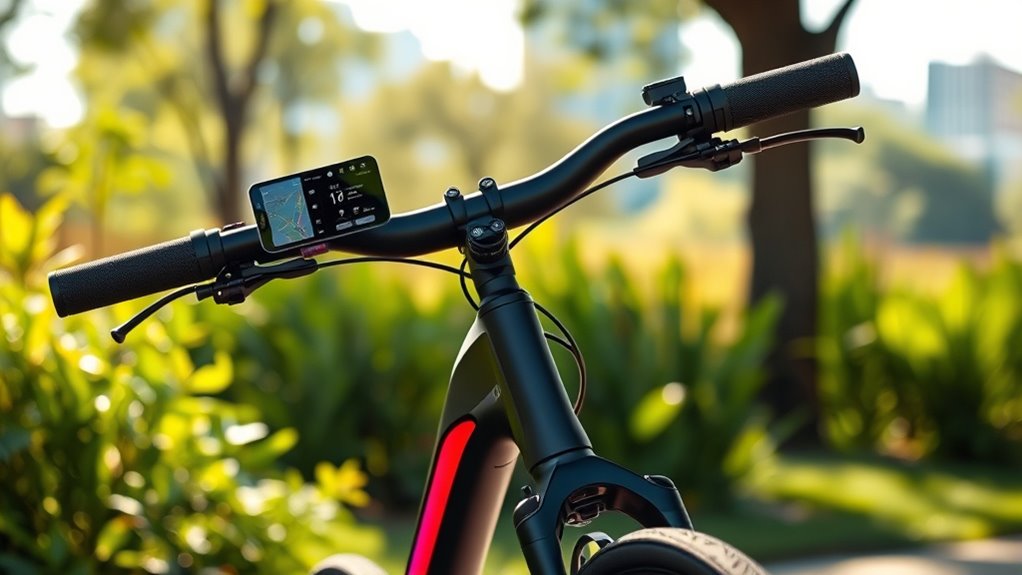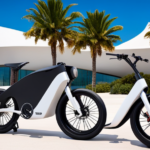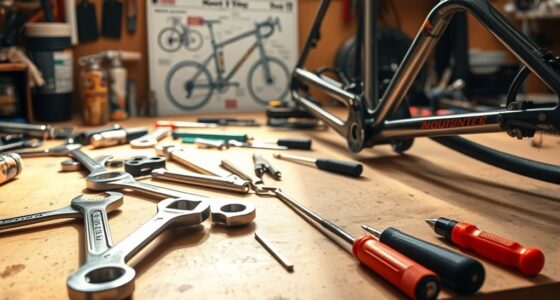By integrating modern technology into your custom bicycle, you can benefit from lightweight materials like carbon fiber and aerodynamically optimized designs that improve speed and handling. Wireless electronic shifting, sensors tracking performance, and digital fitting tools make personalized adjustments easy and precise. Advanced manufacturing like 3D printing enables unique, durable parts, while connectivity features enhance safety and monitor your ride in real-time. Keep exploring to discover how these innovations can elevate your cycling experience even further.
Key Takeaways
- Use advanced lightweight materials like carbon fiber and titanium to reduce frame weight and enhance durability.
- Incorporate wireless electronic shifting and sensor systems for precise gear changes and real-time performance monitoring.
- Utilize digital tools such as 3D scanning and biomechanical analysis for personalized fitting and ergonomic optimization.
- Apply additive manufacturing and generative design to create complex, custom components rapidly and cost-effectively.
- Integrate connectivity features like GPS, crash detection, and performance tracking for safety and enhanced riding experiences.
Advancements in Lightweight Materials and Aerodynamic Structures
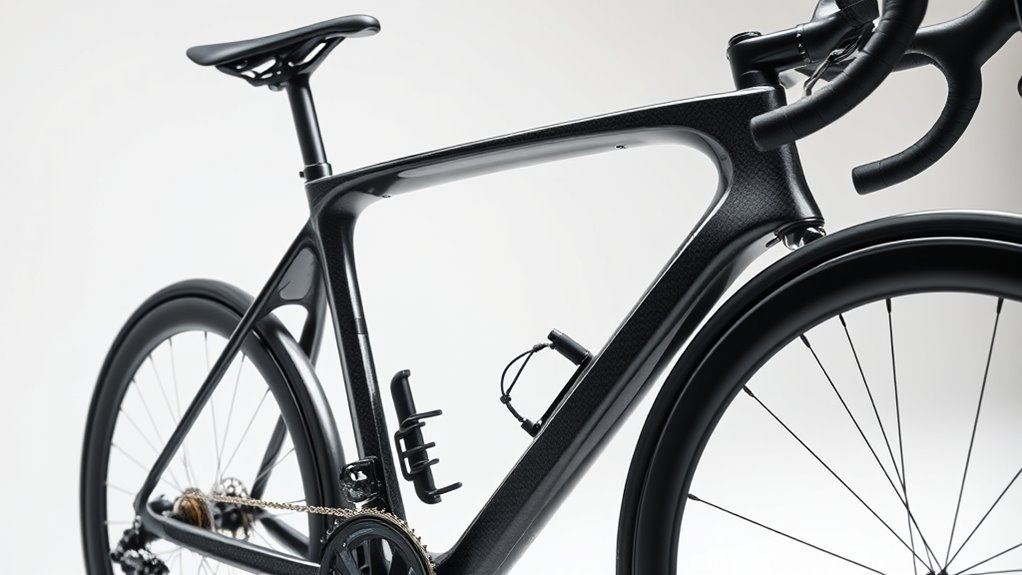
Advancements in lightweight materials and aerodynamic structures have revolutionized custom bicycle design by enabling faster, more efficient rides. Carbon fiber stands out as a game-changer, reducing frame weight to around 1.5 pounds while maintaining strength and stiffness. Using lightweight materials like titanium alloys further cuts weight without sacrificing durability. Aerodynamic structures, including streamlined frames and integrated components, minimize drag and boost speed. These features optimize airflow, often delivering up to 10% faster performance in races. Modern manufacturing techniques like 3D printing and precision molding allow for intricate, aerodynamically optimized geometries previously impossible. Additionally, the integration of high-performance coatings enhances durability and reduces maintenance needs. Incorporating advanced tuning techniques can further refine performance, tailoring the bike to specific riding styles and conditions. By combining innovative materials with advanced aerodynamic designs, you can create a custom bike that’s not only lighter but also more aerodynamic, delivering superior efficiency and performance on every ride.
Electronic Shifting and Wireless Sensor Integration
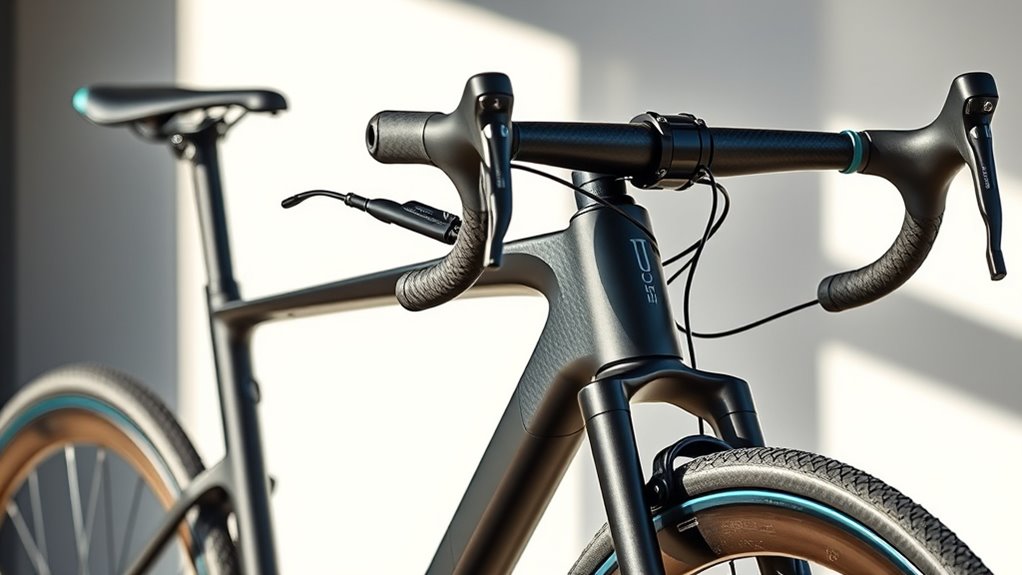
Wireless electronic shifting systems eliminate cables, making gear changes smoother and maintenance easier. Sensors monitor your gear position, cadence, and component status in real-time, providing accurate data to your display or app. This technology guarantees precise shifts even under heavy load, boosting your riding efficiency and safety.
Wireless Connectivity Benefits
By eliminating traditional cables, wireless connectivity transforms how you ride and maintain your bike, offering more precise and reliable shifting while reducing clutter. With wireless connectivity, electronic shifting systems change gears smoothly and quickly, enhancing your riding experience. Wireless sensors gather real-time data like cadence, speed, power output, and suspension performance, transmitting it seamlessly to your display or devices. This instant feedback helps you optimize performance and stay safer on the road. Additionally, remote tuning and customization via smartphone apps make adjustments easy, without needing physical access to components. The reduction of cables cuts weight and creates a cleaner, more aerodynamic design—especially in a custom bike. Wireless technology also plays a crucial role in ensuring consistent data transmission, which is vital for accurate performance monitoring. Reliable wireless communication ensures your data remains accurate and timely during intense rides. Incorporating sound healing science concepts can further improve rider focus and mental clarity during long rides. The integration of advanced digital systems allows for more sophisticated and personalized riding experiences. Regional divorce statistics highlight the importance of reliable support, much like a dependable bike component, ensuring smooth operation. Overall, wireless connectivity enhances your ride with smarter, more efficient tech integrated seamlessly into your bicycle.
Enhanced Shifting Precision
Electronic shifting systems like Shimano Di2 and SRAM eTap deliver precise, instant gear changes with minimal effort, ensuring smooth shifts regardless of rider fatigue or dirt buildup. With electronic shifting, you experience consistent gear precision, reducing mis-shifts and improving overall ride quality. Wireless sensors enhance this system by monitoring gear position, cable tension, and component health in real time, allowing for proactive adjustments and maintenance. These sensors feed data into microprocessors that automatically optimize shifting based on your speed, cadence, and input, further refining gear accuracy. Additionally, integrating wireless sensor data with performance apps gives you detailed insights into shift timing and efficiency. The use of natural materials like wood and linen in bicycle components or accessories can also add a rustic aesthetic to your bike setup. Moreover, the integration of fraud detection techniques in electronic systems can help prevent unauthorized access or malicious interference, ensuring the security of your smart components. Together, electronic shifting and wireless sensors elevate gear precision, making your ride smoother, more responsive, and tailored to your riding style.
Personalized Bike Fitting Powered by Digital Simulations
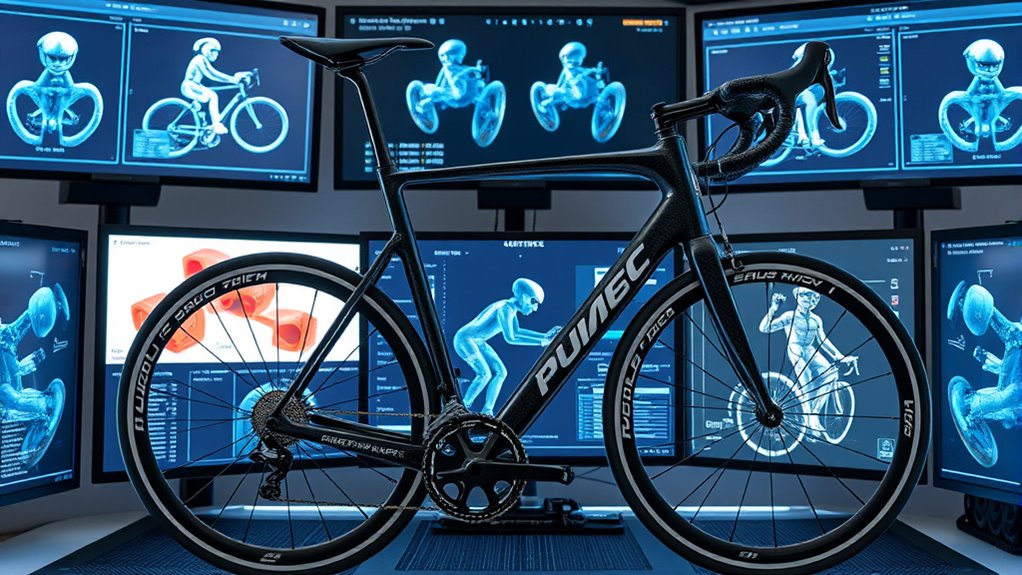
Digital simulations use detailed biomechanical analysis to create a precise fit tailored to your body. With real-time customization tools, you can see immediate adjustments to your bike’s geometry for maximum comfort and efficiency. This technology helps optimize your performance while reducing the risk of injury. Incorporating precise fit techniques can further enhance the customization process by ensuring optimal alignment and comfort. Additionally, integrating user-specific data from modern sensors allows for even more personalized adjustments for each rider. Embracing this technology can also support vibrational alignment by fine-tuning your positioning to promote better energy flow during rides.
Precise Biomechanical Analysis
Innovative digital simulations like Horai enable precise biomechanical analysis by analyzing your unique anthropometrics and movement patterns. This process leverages 3D scanning technologies such as the Occipital Structure Sensor PRO to capture accurate body measurements, guaranteeing a highly personalized fit. By integrating this data, proprietary software models rider-specific parameters like joint angles, reach, and saddle height, optimizing bike geometry for maximum ergonomic efficiency and comfort. This detailed biomechanical analysis guides customization, aligning components and materials with your unique physique. The advanced simulations also allow you to test different riding positions in real-time, enabling rapid iteration and fine-tuning before committing to physical prototypes. This approach ensures your bike fits perfectly and performs at its best, reducing injury risk and enhancing power transfer. Additionally, incorporating Water Parks into your leisure activities can provide a refreshing way to relax and recover after intense training sessions. Moreover, understanding Miscellaneous Business Services can be beneficial when seeking support for managing the business aspects of custom bike manufacturing and sales. Furthermore, utilizing modern digital tools can streamline the customization process, making it more accessible and efficient for both designers and riders. Incorporating market insights from the latest industry trends can also help tailor designs to consumer preferences, increasing satisfaction and sales. Embracing automation in business can also expedite the production workflow, ensuring quicker turnaround times and higher quality standards.
Real-Time Customization Tools
Building on detailed biomechanical insights, real-time customization tools let you see immediate adjustments to your bike’s fit using digital simulations and 3D scanning. With these tools, you can visualize changes to frame geometry, saddle height, and handlebar position before manufacturing begins. Using software like Horai or Occipital Structure Sensor PRO, designers analyze your rider-specific metrics—such as flexibility, riding style, and physical constraints—in real time. This approach streamlines the process, reducing the need for lengthy physical prototypes, and allows modifications within hours instead of weeks. Real-time customization ensures a truly personalized bike fit, optimizing comfort, aerodynamics, and performance based on your unique physical profile. Additionally, integrating retail hours and services can facilitate quicker access to fitting sessions and support. Incorporating customization tools that leverage digital simulations can further improve the precision of these adjustments, ensuring a perfect match for every rider. This technology transforms how bikes are tailored to individual riders, making customization faster, more precise, and highly effective. Moreover, understanding regulatory standards can help ensure that the customized components comply with industry safety guidelines. Implementing predictive modeling can also assist in anticipating future performance needs, further refining the customization process.
Enhanced Performance Optimization
By leveraging advanced simulation software and 3D scanning, personalized bike fitting now offers unprecedented precision tailored to your biomechanics and riding style. Digital simulations analyze your anthropometric data, enabling ideal customization of frame geometry and components. With advanced CAD and real-time rendering, manufacturers can quickly modify designs, reducing prototyping time by up to 16 weeks. Computational fluid dynamics and topological optimization refine carbon fiber layup, boosting aerodynamic efficiency and rider performance. Virtual testing ensures structural integrity and comfort, leading to better power transfer and less fatigue. Additionally, digital twin technology continuously monitors your riding data, allowing ongoing performance analysis and adjustments. This integration of digital simulations transforms bike fitting into a highly personalized process, elevating your overall performance and guaranteeing your bike is perfectly tailored for your needs.
Smart Connectivity and Real-Time Data Monitoring

Smart connectivity transforms custom bicycles into intelligent riding companions by linking them to mobile apps and embedded sensors. With this setup, you can access real-time data monitoring for performance insights, route tracking, and personalized ride settings. Sensors embedded throughout the bike transmit data on speed, cadence, power, and rider posture directly to your device, enabling immediate analysis. These connected systems also support remote diagnostics and maintenance alerts, reducing downtime and keeping your bike in top shape. Real-time data allows you to make precise biomechanical adjustments, improving efficiency and comfort during training or races. Additionally, advanced connectivity features enhance safety, offering crash detection, GPS tracking, and emergency alerts that keep you secure during every ride.
Innovative Manufacturing Techniques: 3D Printing and Additive Manufacturing
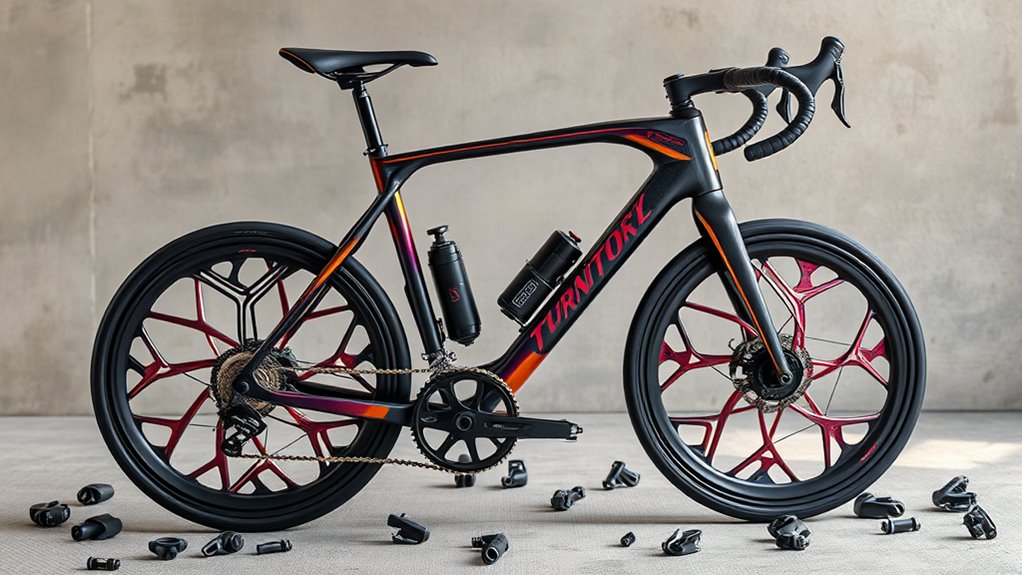
Innovative manufacturing techniques like 3D printing and additive manufacturing are revolutionizing how custom bike components are created. With 3D printing, you can produce complex geometries that traditional methods struggle with, making your bike truly unique. Materials like titanium, Inconel®, and Scalmalloy® allow for lightweight, durable parts tailored to your riding style and needs. Additive manufacturing reduces lead times and costs by eliminating molds and enabling on-demand production of prototypes and small-series components. Advanced techniques, such as continuous fiber filament printing, boost the strength-to-weight ratio of frames and parts, enhancing performance. This approach also allows rapid design iterations and testing, speeding up the development cycle from concept to finished component. Your custom bike benefits from innovation and precision, thanks to these cutting-edge manufacturing methods.
The Role of Computational Fluid Dynamics in Design Optimization

Computational Fluid Dynamics (CFD) plays a crucial role in optimizing bicycle designs by enabling precise airflow simulations around various frame geometries. This technology helps you analyze aerodynamics accurately, reducing drag and improving efficiency. With CFD, you can quickly model complex geometries, allowing for iterative design optimization without building physical prototypes. By simulating different riding conditions, CFD assists in identifying the best tube shapes, angles, and component integration to maximize performance. It also evaluates how materials and surface finishes impact airflow and heat dissipation, informing your material choices. Industry leaders leverage CFD to validate design changes, often achieving up to a 6% improvement in aerodynamics before manufacturing. This integration ensures your custom bike is optimized for speed, efficiency, and overall performance.
Customization Through Digital Twins and Generative Design

By creating a virtual replica of your biomechanics and riding environment, digital twins enable you to customize bike geometry and components with remarkable precision in real time. This technology allows you to test and adjust configurations virtually, ensuring ideal fit and performance before physical production. Coupled with generative design, AI algorithms explore countless design permutations, tailoring frame structures to your specific needs and goals. Integrating digital twins facilitates predictive testing and simulation of bike behavior under various conditions, reducing the need for multiple prototypes. Advanced software combines biometric data, riding style, and environmental factors to generate personalized bike configurations that maximize aerodynamics and comfort. Together, digital twins and generative design streamline customization, delivering bespoke bicycles that meet your unique specifications efficiently and accurately.
Enhancing Safety and Performance With Embedded Electronics
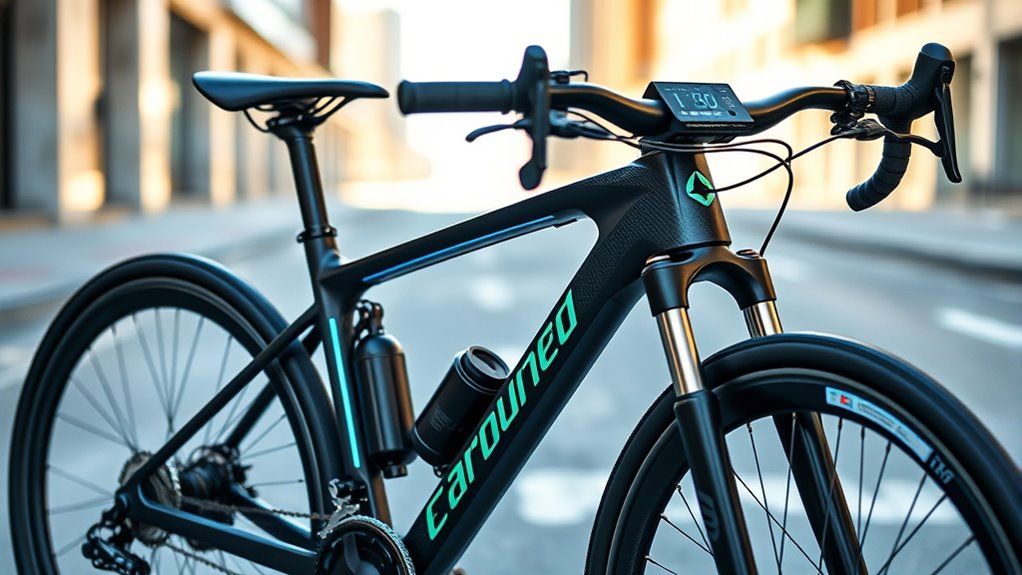
Embedded electronics are transforming the way you ride by seamlessly integrating performance tracking, navigation, and safety features directly into your bike. With GPS modules, accelerometers, and gyroscopes, you get real-time data on your performance and navigation, helping you optimize your ride. Sensors like crash detection and emergency alerts improve rider safety by automatically notifying contacts if an accident occurs. Wireless connectivity allows you to remotely tune your bike, update software, and sync data with your smartphone or cloud platform, making customization easy. Electronic components such as power meters and electronic shifting systems deliver precise gear changes and force measurement, enhancing efficiency. Smart lighting, anti-theft alarms, and display screens increase visibility and security without extra gadgets, ensuring a safer, more efficient ride.
Frequently Asked Questions
How Do Modern Materials Affect Bike Durability and Maintenance?
Modern materials considerably impact your bike’s durability and maintenance. Advanced composites like carbon fiber make your bike lighter and stronger, reducing wear and tear. Aluminum alloys resist corrosion and require less upkeep, while innovative polymers can absorb shocks better. These materials help extend your bike’s lifespan and lower your maintenance needs. You’ll notice fewer repairs, smoother rides, and a longer-lasting bike when you choose modern, durable materials.
Can Electronic Systems Be Customized for Different Riding Styles?
Imagine your bike as a symphony, each electronic system a unique instrument tuned to your riding style. Yes, you can customize these systems—think adaptive gears, smart lights, or performance monitors—to match your terrain and goals. With modern tech, your bike becomes an extension of you, evolving with your skills and adventures. Custom electronic setups let you ride with precision, comfort, and confidence, making every journey truly personalized.
What Are the Privacy Implications of Connected Bike Data?
When you use connected bike data, you should consider privacy implications. Your rides, locations, and personal info get stored and transmitted, which could be accessed by third parties or hackers if not properly secured. You might unknowingly share sensitive details. It’s important to review privacy settings, understand data sharing policies, and choose secure platforms to protect your information. Being aware helps you enjoy the benefits of connected tech without risking your privacy.
How Long Do Embedded Sensors and Electronics Typically Last?
You wonder about the lifespan of embedded sensors and electronics. Typically, these components last between 3 to 7 years, depending on usage, environmental conditions, and build quality. Regular exposure to weather, moisture, and vibrations can shorten their lifespan. To maximize durability, guarantee proper maintenance, use high-quality parts, and protect electronics from extreme conditions. Keep an eye on performance, and plan for periodic upgrades or replacements to maintain functionality.
Are There Any Safety Concerns With Advanced Integrated Technologies?
Ever wondered about the safety risks of advanced tech on your bike? You should consider that embedded electronics and sensors can malfunction or be hacked, risking your safety. Proper installation, regular updates, and quality components minimize these concerns. Are you willing to compromise safety for innovation? Staying informed and vigilant helps ensure your riding remains safe and enjoyable, making technology an asset rather than a hazard.
Conclusion
As you ride into the future, technology becomes your trusted compass, guiding every turn and stride. Like a skilled artisan shaping clay, modern tools mold your bike to fit your dreams perfectly. With each innovation, your ride becomes smoother, faster, and safer — a symphony of progress in motion. Embrace this blend of craftsmanship and innovation, and let your journey unfold seamlessly, carried by the harmony of cutting-edge design and limitless possibility.
